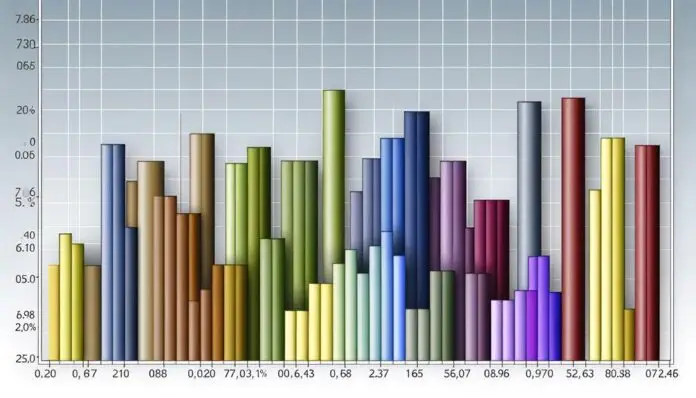When you’re studying market trends, determining critical price points, and working on improving your trading strategies, employing a range bar chart can be a complex yet effective instrument to suit your objectives.
Unlike traditional time-based charts, range bars allow you to track price movements with precision, focusing on volatility rather than the passage of time.
By setting the range to suit your trading style, you can filter out market noise, making patterns and trends easier to spot and potentially improving your entry and exit points.
Yet, as straightforward as range bar charting might seem, its efficacy hinges on your ability to configure and interpret these bars correctly.
In the ensuing discussion, we'll explore the nuances that can make or break the effectiveness of this tool in your trading arsenal, leaving you to ponder: are you using range bars to their full potential, or is there untapped insight lying within their simplistic design?
Key Takeaways
- Range bars offer a clearer picture of price trends and patterns.
- Range bars filter out market noise and improve entry and exit points.
- Range bars help identify trends and support/resistance levels.
- Range bars highlight volatility and key price levels.
Origin and Evolution
Vicente Nicolellis revolutionized charting in the mid-1990s by creating range-bar charts, which focus on price movements and discard the traditional reliance on time intervals. As a Brazilian trader and broker, he noticed that the existing charting methods didn't quite capture the volatility and dynamics of the local markets. To address this, he spent over a decade running a trading desk in Sao Paulo, where he continually refined his approach to market analysis.
During this time, Nicolellis developed the idea of range bars. This innovative concept changed how traders could view and interpret market information. Unlike the standard time-based charts, range bars only form when a specific price movement occurs, offering a clearer picture of price trends and patterns. This methodology allows you to see the market through a lens that highlights volatility and trading activity, not just the passage of time.
The introduction of range bars to the trading platform scene made waves across financial markets worldwide. Their ability to filter out the noise caused by insignificant price fluctuations and to identify true market trends made them a valuable tool for traders seeking to enhance their decision-making process. With range bars, you're equipped to pinpoint entry and exit points more accurately, thus improving your trading performance.
Range bars stand out by providing insights into the market's volatility. When bars appear rapidly, you're alerted to higher volatility, suggesting significant trading opportunities or risks. It's this adaptability and precision that underline the lasting impact of Nicolellis's contribution to charting techniques.
Constructing Range Bars

To construct range bars, you'll first determine the specific price range that, once completed, will define each bar's formation on the chart. Range Bar Charts operate differently from traditional time-based charts; they focus solely on price movement, which can offer you a clearer picture of market trends by filtering out insignificant fluctuations.
Here's what you need to do to set up your range bars:
- Select an Appropriate Range: The size of the bars is crucial. You'll need to pick a specified price movement that suits the instrument you're trading. This range should be large enough to filter out the noise but small enough to capture significant moves.
- Wait for the Bar to Close: A new range bar only begins once the current bar has fully completed the specified price range. If the current bar doesn't exceed the range, it won't close, and a new one won't start.
- Determine the Opening Price: The bar opens at the close of the previous bar. If the previous bar's high or low is breached by the specified range, that's where the new range bar will start.
- Complete the Current Bar: Once the price moves the full range from the bar's open, either up or down, the current bar closes, and a new range bar is formed.
Range bars filter out the noise, so you're left with a chart that reflects pure price movement. This method helps you to identify trends and breakouts more clearly. Remember, choosing an appropriate range is subjective and should be based on the volatility and price behavior of the market you're analyzing.
Analyzing Market Movements

When you analyze market movements with range bar charts, you focus on the essential price shifts, uncluttered by the noise of minor fluctuations. Range bars allow you to scrutinize price movement within a specified range, which can be pivotal in developing trading strategies. Unlike traditional time-based charts, a range bar chart advances only when the market moves by a certain amount, ensuring that each bar represents a meaningful change in price activity.
This method helps you identify trends and support and resistance levels more clearly because irrelevant price variations are filtered out. You'll notice that in volatile markets, your range bar chart will populate with many bars, reflecting the heightened price activity. Conversely, fewer bars will appear during times of low volatility, signaling less market movement.
To tailor your analysis, it's important to set the range of your range bars based on the specific instrument you're trading, its typical price range, and the amount of volatility it experiences. Here's a table to guide you through the key aspects of using range bars for analyzing market movements:
| Aspect | Benefit |
|---|---|
| Price Focus | Eliminates minor price fluctuations |
| Time Independence | Prioritizes price action over time |
| Trend Clarity | Helps identify significant trends |
| Support/Resistance | Aids in locating key levels |
| Volatility Insight | Indicates changes in market dynamics |
Range Bar Trading Techniques

Harnessing the power of range bar charts in your trading arsenal can significantly sharpen your ability to spot entry and exit points in the markets. Unlike traditional time-based charts, range bars focus on price movement within a specified price range. Each new bar signals a meaningful shift in market price, allowing you to filter out noise and hone in on significant trends.
To make the most of range bars in trading, consider the following techniques:
- Identify Key Support and Resistance Levels: Use range bars to pinpoint areas where the market price has repeatedly reversed or consolidated. These levels can act as crucial points for future price movements.
- Spot Breakouts and Reversals: A new bar forming outside a known support or resistance area can indicate a potential breakout. Conversely, a stall in bar formation at these levels may suggest an impending reversal.
- Reduce Market Noise: By focusing on a specified price range, range bars help you filter out noise in the market. This can lead to clearer analysis, allowing you to focus on true market momentum without the distraction of minor fluctuations.
- Backtest Your Strategy: Always validate your trading strategy by backtesting with range bars. This process will help you determine the optimal range settings for your trading style and the securities you trade.
Comparing Chart Types

While range bar trading techniques offer a streamlined method for identifying market trends and key price levels, comparing them with other chart types like Japanese candlesticks and Renko charts can further enhance your trading analysis. You'll find that each chart type has its own set of advantages and disadvantages, which can be crucial in refining your technical analysis.
Let's lay out some key differences in a table format:
| Chart Type | Key Features | Advantages and Disadvantages |
|---|---|---|
| Range Bars | No time axis, just price movement | Reduces noise, highlights volatility; less frequent updates |
| Candlestick Chart | Time-based charts with open, close, high, low | Detailed price action, popular; can be noisy |
| Renko Chart | Price movement, no time axis, size of bricks fixed | Filters out minor price movements; may miss short-term signals |
Range bars are unique in that they don't rely on a time axis. Your focus is solely on price movement, which can help you cut through the market noise. This quality is especially useful in markets with high volatility, where the clarity of range bars allows for potentially cleaner analysis of trends and breakouts.
On the other hand, time-based charts like the candlestick chart incorporate more information in their visuals. You're looking at open, close, high, and low prices for specified time intervals, which can provide a more nuanced look at market sentiment.
Frequently Asked Questions
What Is the Range Bar Method?
You're exploring technical analysis through charting techniques that focus on price action. The method analyzes market volatility, trading strategies, and bar patterns, refining data interpretation and timeframe selection in financial markets, considering investor psychology.
How Do You Plot Range Bars?
You'll plot bars by setting a price range that, once hit, completes a bar. This method enhances chart clarity, compresses data, filters market noise, and aids in volatility assessment and trend identification.
What Do Range Bars Show?
You'll see price movements, market trends, and volatility visualization. They're great for spotting chart patterns and making informed trading decisions, while highlighting support levels, resistance zones, and price consolidation, and filtering out market noise.
What Is Range Bars in Tradingview?
In TradingView, range bars enhance your analysis with benefits like clear market trends, price consolidation views, volatility insight, and sharper chart clarity, aiding in refining entry points, stop losses, and overall risk management.
Conclusion
You've seen how range bar charting strips away the noise by focusing on price alone, not time. By setting the range to match your trading style, you can spot clearer trends and patterns.
Whether you're drawing support lines or eyeing breakouts, this technique can refine your analysis. It's unique, compared to time-based charts, offering a fresh perspective.
Harness the simplicity of range bars to elevate your trading decisions and potentially gain an edge in the markets.



